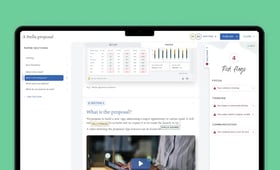How do we solve the 5 most common mistakes in board packs? Here are 5 quick and easy solutions.
1. Problem: Information over insight
Solution: Report writing training
When writing a board paper, management need to put themselves in the shoes of the board. The board don’t just want an update of what’s been happening in the business — they want to know the ‘why?’ and ‘so what?’.
Great board papers cover the context, facts and figures in as few words and data points as possible, and focus their attention on what’s driving the results and the implications for the organisation. However, this is easier said than done and few of us have been trained in how to write (or present data) holistically and succinctly in a business context. Short training courses that cover how to structure information, with journalistic tips and tricks, can make the world of difference.
The briefing process is an essential and often overlooked part of preparing board papers. Report writers need to be clear on the specific questions that the board need answered. Structuring the report around these questions helps to ensure the paper is focused on what matters and that it contains neither critical gaps nor reams of irrelevant information. Before your report writers put pen to paper, encourage them to sit down with their paper sponsor and agree the brief — in particular, agreeing the purpose of the paper and the high-level questions it needs to address.
2. Problem: Too backward-looking
Solution: The right questions
This requires a mindset change for many report writers to step away from the comfort zone of retrospective financial metrics and KPIs, and put forward their view of what’s around the corner. Management need to focus on the underlying drivers of the business in order to explore what might be about to happen, rather than focus on what has already passed.
We recommend considering the following questions to help prepare a more forward-looking report:
- What’s driving the results and what does this mean going forwards?
- What risks and opportunities are on the horizon — and what should we be doing about them?
- How confident are you in delivering the plan?
3. Problem: Too long
Solution: Get prescriptive about length
The average board pack is around 288 pages long, yet board directors only spend around 3 hours reading their packs — which suggests they’re only reading about 100 pages in the available time. We recommend being both explicit and ruthless about the length allowed for each paper: 3 to 5 pages is plenty for almost any topic. In fact, some boards will automatically reject any paper that creeps over the page limit. If you can combine a strict page limit with a rigorous brief to ensure report writers focus on the correct questions, boards can avoid missing out on critical information.
Finally, if the topic is particularly complex and you think extra pages are essential, the report length should be agreed with the Chairman to avoid the 50+ page reports that can be common place in many board packs.
4. Problem: No clear idea of materiality or the input required
Solution: Better executive summaries
A simple cover sheet explaining whether the paper is to note, to discuss or for a decision is a start, but a good executive summary should be so much more than that. From a single page, the board should know why they are receiving the paper, how material the issue is, the main questions the report addresses, the main conclusions it draws and what they are expected to do next. We recommend using a template for this to ensure the board consistently receive high quality executive summaries across the organisation.
Done properly, an executive summary is the most critical part of every board paper. And asking a report writer to start by drafting the executive summary is a great way to check that the brief has been properly understood, before time is spent writing the body of the paper.
5. Problem: Not enough strategic discussion
Solution: Get decision and discussion papers on the agenda
This is really two solutions in one.
The first is to be ruthless about your planning and to start each meeting tackling the items of most strategic importance, so everyone debates these feeling fresh. The best boards map out the most important discussions 6 — 12 months ahead and work hard to ensure time is safeguarded for those items, even in the face of the urgent distractions that arise. We recommend using our Six Conversations Model to identify the important discussions your board needs to have this year.
The second is to ensure that when these items come to the board they are accompanied by a clear and concise decision and discussion paper, so that the main issues are well understood by everyone before the meeting begins. A good way to do this is to plot out the decision criteria that matter to the board, for each type of decision, and to ensure that report writers ruthlessly focus on answering those questions.
Now that you’re on your way to a better board pack, the next question is — what does best practice look like? Sign up to one of our Best Practice Board Packs Uncovered roundtables to find out more.
In the meantime, if you would like to discuss any of the solutions above or see how Board Intelligence could help your organisation get the most from their board packs, get in touch.



